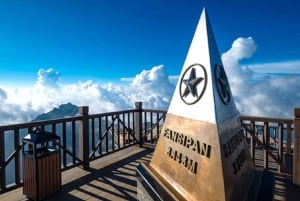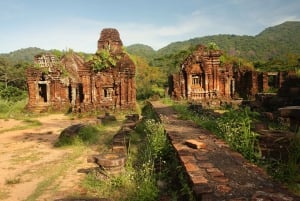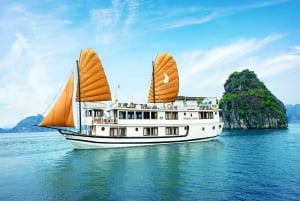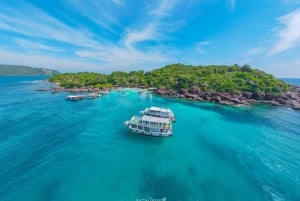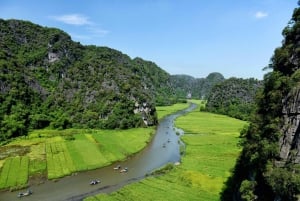Weather Overview
Our guide to Vietnam Weather Forecast by our Vietnam local expert - Vietnam’s climate is tropical in most places and during most times of the year, however, places especially in the North of Vietnam have a diverse climate and can be cooler during some times of the year.
Vietnam’s climate is tropical in most places and during most times of the year, however, places especially in the North of Vietnam have a diverse climate and can be cooler during some times of the year.
When you are planning where you are going to visit and what activities you want to enjoy, considering the weather and climate conditions is very important for your planning. The weather can affect how much one enjoys their vacation, and of course we want you to have the best experience! With the stretch of Vietnam spanning more than 2,000 miles between the Northern lands of Sapa and Hanoi and the Southern tips of the Mekong Delta and Ho Chi Minh City, the weather varies vastly.
Fortunately, regardless of when you plan to visit Vietnam, our weather and best times to visit foresight can help you can maximize your time in the kind of weather you’re seeking. We also realize that each traveler will have different preferences. Some people prefer to visit places during the busiest high seasons, while others prefer to avoid tourist crowds. And when it comes to weather- certain weather can be more important for some people to avoid or to pursue.
Northern Vietnam
Region Characteristics: Mountainous, with wet and hot summers and dry and cold winters. The weather here experiences the more typical spring, summer, autumn, winter pattern. The rainy season is moreso summer and autumn and dry season is roughly winter and spring.
- Spring: January- April
- Summer: May- July
- Autumn: August- October
- Winter: November-January
April to September: Expect temperatures to range from 25 °C to 35°C (hotter in the summer months), with bursts of heavy rain that can vary in intensity from week to week.
November to March: Expect temperatures to average around 20°C, and even drop to less than 15°C in the far North during the winter months. It can also still rain during these months, but not nearly as often. February and March in particular can experience drizzle and overcast skies.
Local Tip: Pack smartly to be prepared for chilly weather in December and January – you may even see snow in the far mountainous North! Although the temperature drops in the dry season, it is considered by many to be much more pleasant to visit the places in Northern Vietnam during this time, so if you like cooler weather, consider visiting Northern Vietnam around the late autumn or winter months.
Local Tip: If you plan to hike Fansipan when you visit the North, please avoid the rainy season from May to September!
MORE Travel Tips for Destinations in the North
Sapa - There isn’t actually a bad time to visit Sapa, as it holds scenic beauty in all weather. However, if you want to avoid the extreme cold months, don’t plan your visit for the winter months. In the early spring (i.e. April), the flora and fauna is at its peak: flowers are blooming so the scenery is colorful and lightly scented. If you’re more interested in seeing the uniquely manicured, green rice terraces, you have to visit during the later Autumn days since this is their one harvest time each year.
Hanoi - From October to December Hanoi experiences mostly clear and sunny days and less humidity than other times of the year, making this the best time to visit.
Ha Long Bay - The wet season is not the best time to plan your once in a lifetime cruise through these mystical waters! When storms are more prevalent in the Bay area, cruises are frequently cancelled or cut short when there is a storm warning.
Central Vietnam
Region Characteristics: Coastline and mountainous highlands areas.
However, the geography of Central Vietnam makes the cities vary in temperature and climate because they are split by a curving mountain range. Generally speaking, the “Central Coast” experiences greater heat and the “Central Highlands,” greater precipitation.
Furthermore, the cities within the Central Coast can be figuratively split between North and South areas. The more Northern cities of the Central Coast area, (including Da Nang, Hoi An, Hue) experience weather patterns more similar to Northern Vietnam. The Southern cities of the Central Coast, (including Nha Trang, Phan Thiet) remain drier throughout the year.
- August to December: This is the wet season, and it can bring typhoons and rough rain storms! Aug-Nov is the most rainy period for the Northern Cities within this region and Oct-Dec is the most rainy period for the Southern Cities within this region
- January to July: This is the dry season for Central Vietnam, and these areas tend to stay hotter and drier for most of the year round.
Local Tip: January to August is considered by many to be the best weather, with little rain and an average temperature of 25°C.
Local Tip: For surfers or kitesurfers, head to China Beach in Danang or Bai Dai (South of Nha Trang), during November through April for the best wave action. For divers, June through August is the best time for calm water visibility.
More Travel Tips for Destinations in Central Vietnam
Dalat - This city is quite different than other places in Central Vietnam because the city is perched in the mountainous highlands. It is known for outdoor adventure sports like canyoneering and whitewater rafting, and weather consideration is vital when planning these activities, since excursions can be cancelled during the wet season (June to October) if the water levels are too high or if the current is too strong. Because it is set in mountainous terrain, Dalat is definitely cooler than the coastal area as well, particularly from November to March when the temp averages around 15°C.
Nha Trang - There is a reason this beach is so popular- you can expect sunshine almost all year round- apart from November through December, when the area can experience occasional heavy rain. This beach is at its best and most beautiful in April, but that’s why most tourists choose to go at this time or during the other peak tourism times of June-August. To avoid the peak tourism times and enjoy the beaches with a little more privacy, early September is an ideal time to visit, as the weather is still nice enough and it doesn’t rain too often.
Hue - The Phong Nha caves near Hue are a popular tourist destination and a must see if you will be traveling in this area. One of the most unique experiences here is to be able to swim in the river that runs through the caves but this is only possible in the dry months. During the wet season of November and December, the water level is too high and may even flood, so they can close the caves to visitors.
DaNang - In late April, Da Nang hosts an annual fireworks competition and the river-front explodes with light and celebration. The best time to visit Da Nang is considered to be from February to May, when the skies are clearer and humidity levels are lower. If you want to avoid the hottest and most crowded time here, avoid the summer months of June through August (with temperatures around 33°C).
Hoi An - Many people feel that the best time to visit Hoi An is between February and May, when rainfall is low and temperatures are comfortable, but others agree that it is better to wait a bit longer. From May to July, when the crowds disappear and it’s considered “low season”, it actually becomes perfect beach weather with temperatures averaging around the mid-30’s. This means it’s less crowded for taking photos, bartering down the tailors is easier, and room prices become surprisingly more affordable! And for divers- conditions are at their best during this time!
Southern Vietnam
Region Characteristics: The cities in the South also vary considerably weather-wise, but the climate here is more temperate than Northern and Central Vietnam, and it remains around 25 -35°C year round. Yet, even though the temperature is roughly the same all year, the humidity varies greatly, so the climate feels different.
- May to October: This is wet season. Expect temperatures between 30-35°C with almost daily bursts of heavy rain, varying in intensity from week to week.
- November to April: This is dry season. Expect temperatures between 21-35°C. It will be hot and humid, but it is slightly more temperate from February-April, making these the best months to visit Southern Vietnam, thanks to staying dry!
Local Tip: During the rainy season, do as the Vietnamese do and purchase a rain poncho for about 40,000 VND off any street cart, and be prepared for potential daily rain. Often it’s sporadic and only temporary, bringing back sunny skies after it passes! However, sometimes you might get rained out- so make it a rainy day at one of the many movie theaters or duck into an atmospheric restaurant.
More Travel Tips for Destinations in Southern Vietnam
Phu Quoc - Phu Quoc gets more rainfall than other parts of Southern Vietnam and the waters are less blue and more choppy during wet season, (although Phu Quoc is still highly visited year round. The island is still developing, and many of the roads are not fully built, so if you want to make your way by bike to other beaches on the island during wet season, be prepared for a very muddy trip!
Con Dao Islands - Isolated from the mainlands, these islands experience their own climate patterns, with November to February being the driest months and a rainy season between June and September. From May to November, the World Wildlife Foundation that works with the Con Dao National Park set up ranger stations to rescue the nests that turtles create
Ho Chi Minh City - February is a beautiful month in Ho Chi Minh city, as the city is preparing for the Tet holiday and the city is filled with flowers and decor, and this time is typically the least humid and rainy. The dry season months in general are best for visiting the city of Saigon, as getting around to sightsee is of course easier.
Mekong Delta- March might just be the best time to visit this region, as the summer heat and rain hasn’t quite begun, and the Tet madness has disappated. Another exciting thing to see in this region is the Khmer people’s longboat festivals in November.
 21 °C
21 °C
 light rain
light rain light rain
light rain light rain
light rain light rain
light rain light rain
light rain light rain
light rain light rain
light rain light rain
light rain overcast clouds
overcast clouds overcast clouds
overcast clouds overcast clouds
overcast clouds overcast clouds
overcast clouds light rain
light rain moderate rain
moderate rain light rain
light rain light rain
light rain light rain
light rain light rain
light rain overcast clouds
overcast clouds overcast clouds
overcast clouds light rain
light rain moderate rain
moderate rain heavy intensity rain
heavy intensity rain moderate rain
moderate rain light rain
light rain moderate rain
moderate rain moderate rain
moderate rain light rain
light rain light rain
light rain light rain
light rain light rain
light rain light rain
light rain light rain
light rain overcast clouds
overcast clouds light rain
light rain overcast clouds
overcast clouds overcast clouds
overcast clouds light rain
light rain light rain
light rain overcast clouds
overcast clouds

